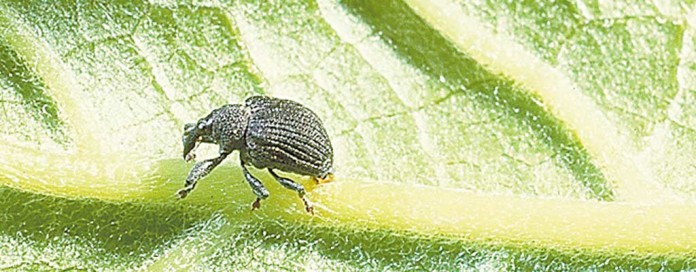
UNIVERSITY PARK, PA. — Many residents in Pennsylvania and neighboring states are getting “ticked” about an insect that has made its presence known in large numbers this spring and summer. But this bug is not a species of eight-legged arthropod known to carry Lyme disease and other pathogens.
Not a tick
It’s the yellow poplar weevil, a small (about 3 millimeters long), black snout beetle that has been seen in large numbers crawling on vehicles and other surfaces and on plants in landscapes and ornamental nurseries.
Mistake
Some people have mistaken these weevils for ticks because they count the insects’ pair of antennae as a “fourth pair” of legs. However, yellow poplar weevil is harmless to people.
There has been a widespread spike in the population of this native insect in Maryland, North Carolina, Ohio, Pennsylvania, Virginia and West Virginia, according to Gregory Hoover, ornamental extension entomologist in Penn State’s College of Agricultural Sciences.
“The level of this year’s outbreak has not been seen since 1968,” he said. “The yellow poplar weevil overwinters as an adult in the leaf litter,” Hoover said. “When the weather warms in the spring, adults emerge and may feed on the swelling host plant buds. Mating and egg laying occur from May to early June.”
Eggs
He noted that eggs are laid in the midrib on the lower leaf surface of the host, and newly hatched larvae bore into the leaf tissue to feed as leafminers. There may be from one to 19 larvae that develop in one blotch leaf mine.
“The larval stage of the yellow poplar weevil may mine the foliage of tuliptree or yellow poplar, magnolia and sassafras,” he said.
“Larvae undergo the molt into the pupal stage in the leaf mine. Adults start to emerge in southern Pennsylvania during mid- to late June. Adults have a snout with chewing mouthparts that they use to feed on host plant tissue and may cause the most foliar damage to the host plant.”
Hoover explained that premature leaf drop may occur on damaged tuliptree or yellow poplar foliage during drought conditions. By mid-July, he said, most adults enter a period of inactivity and will enter the leaf litter to overwinter.
One generation
This species has one generation each year.
“If indicated, yellow poplar weevil adults may be managed with registered insecticide formulations containing the active ingredients bifenthrin or carbaryl that should be applied in late June to early July according to all label directions,” said Hoover, who is attempting to document the geographic distribution of the weevil outbreak.
“I’d like to know where in Pennsylvania — besides the counties of Allegheny, Centre, Cumberland, Franklin, Indiana, Somerset and Westmoreland — the yellow poplar weevil has been abundant in the past few weeks,” he said.
To report infestation
Residents can report infestations to Hoover via email at gah10@psu.edu.









